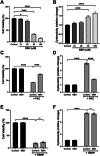Salicylaldehyde Benzoylhydrazone Protects Against Ferroptosis in Models of Neurotoxicity and Behavioural Dysfunction, In Vitro and In Vivo
- PMID: 40515790
- PMCID: PMC12167254
- DOI: 10.1007/s12031-025-02371-2
Salicylaldehyde Benzoylhydrazone Protects Against Ferroptosis in Models of Neurotoxicity and Behavioural Dysfunction, In Vitro and In Vivo
Abstract
Metal dyshomeostasis in the brain is a key feature of many neuropathologies, including hypoxic and traumatic injury and chronic conditions such as Alzheimer's and Parkinson's disease. Ferroptosis is a form of cell death driven by the intracellular accumulation of iron. This is primarily characterised by a loss in endogenous antioxidant capacity and uncontrolled lipid peroxidation. Ferroptosis has been reported to underlie the pathology associated with several neurological and neurodegenerative conditions and has, therefore, become an attractive target for therapeutic intervention. Salicylaldehyde benzoylhydrazone (SBH) is a specialised hydrazone agent, known for its antibacterial and anticancer properties. It has robust metal-chelating capacity, with a particular affinity for complexing with iron and copper. The current study sought to investigate the potential of SBH to act as an anti-ferroptotic agent and to alleviate the neurotoxic and dysfunctional consequences of iron overload. We demonstrate that SBH can alleviate the death of HT22 hippocampal neurons, induced by exposure to the iron donor, ferric ammonium citrate (FAC). This was accompanied by a reduction in intracellular iron and lipid peroxidation, and alleviation of hallmark changes in gene expression indicative of ferroptosis. Using FAC-incubated zebrafish larvae as an in vivo model of iron overload, we reveal that SBH can reduce the mortality and toxicity associated with FAC exposure. Moreover, we report a FAC-mediated dysfunction in intrinsic sensorimotor reflex behaviour, which is restored by SBH. Taken together, our findings highlight SBH as an anti-ferroptotic agent and support its further investigation as a potential neurotherapeutic for conditions associated with iron dysregulation.
Keywords: Ferric ammonium citrate; HT22 cells; Iron overload; Lipid peroxidation; Schiff base; Zebrafish larvae.
© 2025. The Author(s).
Conflict of interest statement
Declarations. Ethical Approval: Zebrafish rearing and husbandry were performed in accordance with the regulations of the Linköping Animal Research Ethics Committee. All experiments were carried out on zebrafish in their larval form (≤ 5 days post-fertilisation) and therefore not subject to ethical evaluation, in accordance with Article 23 of European Directive 2010/63/EU. Consent to Participate: Not applicable. Consent for Publication: All authors consent to the publication of this manuscript. Competing interests: The authors declare no competing interests.
Figures




Similar articles
-
Unveiling the shield: Troglitazone's impact on epilepsy-induced nerve injury through ferroptosis inhibition.CNS Neurosci Ther. 2024 Aug;30(8):e14911. doi: 10.1111/cns.14911. CNS Neurosci Ther. 2024. PMID: 39145422 Free PMC article.
-
Artemisinin inhibits neuronal ferroptosis in Alzheimer's disease models by targeting KEAP1.Acta Pharmacol Sin. 2025 Feb;46(2):326-337. doi: 10.1038/s41401-024-01378-6. Epub 2024 Sep 9. Acta Pharmacol Sin. 2025. PMID: 39251858
-
Activation of the Nrf2 Signaling Pathway by Tetrahydroberberine Suppresses Ferroptosis and Enhances Functional Recovery Following Spinal Cord Injury.Mol Neurobiol. 2025 Jul;62(7):8439-8456. doi: 10.1007/s12035-025-04791-y. Epub 2025 Feb 26. Mol Neurobiol. 2025. PMID: 40011360
-
Signs and symptoms to determine if a patient presenting in primary care or hospital outpatient settings has COVID-19.Cochrane Database Syst Rev. 2022 May 20;5(5):CD013665. doi: 10.1002/14651858.CD013665.pub3. Cochrane Database Syst Rev. 2022. PMID: 35593186 Free PMC article.
-
Ferroptosis as a potential molecular mechanism of bipolar disorder.Transl Psychiatry. 2025 Jun 19;15(1):205. doi: 10.1038/s41398-025-03429-w. Transl Psychiatry. 2025. PMID: 40537482 Free PMC article. Review.
References
-
- Adeleke AA, Zamisa SJ, Islam MS, Olofinsan K, Salau VF, Mocktar C, Omondi B (2021) Quinoline functionalized schiff base silver (I) complexes: interactions with biomolecules and in vitro cytotoxicity, antioxidant and antimicrobial activities. Molecules 26(5):1205. 10.3390/molecules26051205 - PMC - PubMed
-
- Aigner E et al (2008) Copper availability contributes to iron perturbations in human nonalcoholic fatty liver disease. Gastroenterology 135:680–688. 10.1053/j.gastro.2008.04.007 - PubMed
MeSH terms
Substances
Grants and funding
- GOIPG/2024/3286/Research Ireland/Taighde Éireann
- GOIPG/2024/3286/Research Ireland/Taighde Éireann
- 101007931/European Union's Horizon 2020 Marie Skłodowska-Curie Actions
- 101007931/European Union's Horizon 2020 Marie Skłodowska-Curie Actions
- 101007931/European Union's Horizon 2020 Marie Skłodowska-Curie Actions
LinkOut - more resources
Full Text Sources

